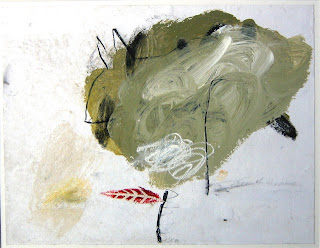
Untitled, 1999
Mixed media on paper
8 ¾ x 13 in.
$ 700
if ART
presents at
Gallery 80808/Vista Studios
808 Lady St., Columbia, S.C.
THE LINE ACCORDING TO
Roland Albert – Mary Gilkerson – Sjaak Korsten
&
Kees Salentijn
August 29 – September 9, 2008
Artists’ Reception: Friday, August 29, 2008, 5 – 10 p.m.
Opening Hours:
Saturdays, 11 a.m. – 5 p.m.
Sundays, 1 – 5 p.m.
Weekdays, 11 a.m. – 7 p.m. and by appointment
For more information, contact Wim Roefs at if ART:
(803) 238-2351/255-0068 – wroefs@sc.rr.com
For its August – September exhibition, if ART presents at Gallery 80808/Vista Studios The Line According to Roland Albert, Mary Gilkerson, Sjaak Korsten & Kees Salentijn. German artist Albert will present mixed media, mostly wood-based sculptures, and Columbia’s Gilkerson, a new series of monotypes. Dutch painter Salentijn will show paintings, mixed media works on paper, painted ceramic plates, lithographs and silkscreens. Korsten, another Dutch artist, will show mixed media works on paper. Korsten has recently joined if ART Gallery, and the upcoming exhibition will be his first in the United States.
Albert (b. 1944) is a widely respected painter and sculptor in Germany. He is part of the artists’ exchange between Columbia and its German sister city of Kaiserslautern. Albert studied with the famous Greek-American sculptor Kosta Alex in Paris in 1964. In 1970, he graduated from the prestigious Munich Academy of Fine Arts. Albert’s work overall fits European post-World War II contemporary traditions. He shares Joseph Beuys’ love for rough and unfinished materials. Like Art Informel artists such as Spaniard Antoni Tapies and fellow German Emil Schumacher, Albert considers not just forms and shapes important but also the tactile and physical quality of his materials.
Gilkerson (b. 1958) has recently completed monotypes for her Three River series based on Columbia’s Congaree, Saluda and Broad rivers. The sometimes strongly abstracted works are based on photos and drawings Gilkerson made earlier this year during walks along the riverbanks. Gilkerson for many years has been prominent on the art scene of the South Carolina Midlands as an artist, critic and curator. She teaches art at Columbia College in her hometown of Columbia. Gilkerson holds BFA, MA and MFA degrees from the University of South Carolina.
Korsten (b. 1957) is widely known and respected in the Netherlands. Not unlike Albert, he works in established post-World War II European modern and contemporary traditions. His work is related to Art Informel artists such as Tapies, Jaap Wagemaker, Wols, Jean Fautrier and Manalo Millares. Much of the focus in their work and that of Korsten is on materials and surface. While Korsten’s work is heavily abstracted, he typically includes representative elements. Korsten’s work has been shown at major European fairs, including TEFAF Maastricht, PAN Amsterdam and the Cologne Art Fair.
Salentijn (b. 1947) is among The Netherlands’ most prominent painters. The initial inspiration leading to his mature style came from post-war American art and from Spanish painters such as Tapies, Antonio Saura, and later Millares. Salentijn developed a personal style that combined the expressionist, painterly swath with smaller but equally expressionist marks that are quick and slightly nervous but sure. Combining vigorous painting with often-childlike imagery, Salentijn’s work eventually placed him in the Northern European, post-war CoBrA tradition of strongly expressionist, abstracted art that containes representational elements. Salentijn’s increased use of figuration in the 1990s confirmed this link. His work is in several European museums. In addition to the 1982 Chicago Art Fair, his work has been represented at major European art fairs, including Art Fair Basel, TEFAF Maastricht, Kunstmesse Cologne and KunstRAI Amsterdam.






















